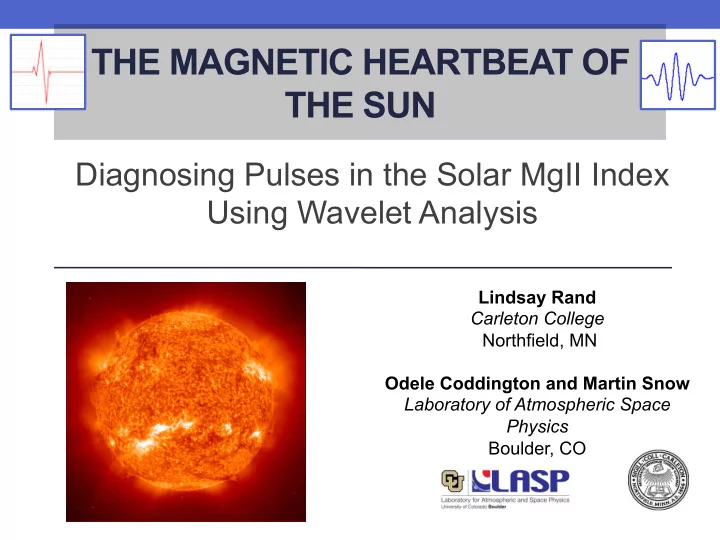

THE MAGNETIC HEARTBEAT OF THE SUN Diagnosing Pulses in the Solar MgII Index Using Wavelet Analysis Lindsay Rand Carleton College Northfield, MN Odele Coddington and Martin Snow Laboratory of Atmospheric Space Physics Boulder, CO
Solar Magnesium II Index • What is it? • Measures core-to-wing ratio in solar UV irradiance Spectrum around 280 nm Stable Absorption wings (upper photosphere) Variable Emission Core (upper chromosphere) • What is it used for? • Solar chromosphere variability proxy • Space weather prediction • Climate variation
Problem • Currently there are many different instruments taking data measurements • Instruments have different • Time periods • Platforms • Spectral resolutions • Uncertainty • Different data sets follow diverging trends • Leads to different models and predictions
Approach • Take three data sets with overlapping time periods • Bremen Composite, NOAA 16, SORCE Solstice NOAA Bremen SOLSTICE • Apply wavelet analysis to extract known solar time scales • Investigate remaining trends • Apply Bayesian Method to construct composite MgII Index
Wavelet Analysis • First, think of Fast Fourier Transform (FFT): Mysterious pulse Try frequency 1: poor correlation Try frequency 2: good correlation Try frequency 3: poor correlation
Wavelet Analysis • We can use Wavelet Analysis to find frequency and temporal position Mysterious Pulse Pulse 1: Poor temporal and frequency correlation Pulse 2: Good temporal, poor frequency correlation Pulse 3: Good temporal, good frequency correlation
Initial Results –Global Power Spectra Solar Rotation Active Region Lifetime
Active Region NSO/Kitt Peak Magnetic Field Synoptic Map Lifetime (4-7 month) Solar Rotation Active Region Lifetime
Initial Results –Global Power Spectra Likely 11 Solar year cycle Rotation Active Region Lifetime Year long cycle?
Solstice Initial Results- Wavelet Power Spectra NOAA Period Index Bremen Period Period
SOLSTICE Mg II Record and Signal Elements -isolated signals -wavelet allows us to visually see where they occur
Deconstruction Process (misnomer slide) • First want to fully reconstruct (all wavelet periods) signal to match index • Problem: time period not long enough to reconstruct 11 year • Need to extrapolate Bremen-11 year for full reconstruct
Now we can deconstruct! • First take out all known solar cycles
Taking out the 11- year solar cycle
Extracting Solar Rotational Periods and Half Solar Rotational Period
Extracting Active Region Period With all known solar periods taken out we still have a 1-2 year period!!!
Taking out 1-2 year period (any other mystery signals?)
1-2 year signal investigation • Common to all three data sets (NOAA, SOLSTICE, Bremen) • What about ground-based solar chromosphere variability data? • Use San Fernando Observatory (SFO) Ca II data
SFO Data Comparison • 1-2 year signal is common to space-based and ground-based instruments
Compare with Temporal Difference in Hemispheric Sunspot Number
Cross-data set comparison problems -scaling -phase This is where we can benefit from Bayesian Approach
Quantifying uncertainties through Informed Source Separation We consider performing the linear transformation within The wavelet analysis/reconstruction a Bayesian model, which allows for quantifying the is a linear transformation and does uncertainties in the reconstruction. not account for uncertainties. Informed Source Separation: Linear Mixing Model Bayesian Positive Source Separation [Moussaoui et al., 2 p ( s , A ) = p ( x − A s ) p ( s ) p ( A ) i i,t ∑ Posterior x = i Measuremen A priori PDF As A priori PDF t Error PDF (abundance PDF s) (wavelet signal) Most ¡probable ¡solu-on ¡is ¡obtained ¡through ¡itera-vely ¡solving ¡a ¡ hierarchical ¡(“Layered”) ¡Bayesian ¡Model. ¡ ¡ These ¡are ¡the ¡steps: ¡ 1. ¡Define ¡first ¡guess ¡sources ¡& ¡abundances. ¡ 2. ¡Es-mate ¡gamma ¡distribu-on ¡abundance ¡parameters. ¡ x=data 3. ¡Op-mize ¡New ¡Abundance ¡es-mate ¡ ¡ A i =Abundance of i th element 4. ¡Es-mate ¡source ¡hyperparameters. ¡ s i,t =i th signal element (time- 5. ¡Op-mize ¡new ¡Sources ¡es-mate. ¡ dependent) 6. ¡Es-mate ¡noise ¡parameters ¡that ¡minimize ¡x-‑As. ¡ If ¡ convergence ¡reached, ¡evaluate ¡posterior ¡PDF ¡for ¡final ¡ es-mates ¡of ¡sources ¡and ¡abundance. ¡ Else , ¡iterate ¡and ¡re-‑ evaluate. ¡ ¡
Initial Bayesian Results: SOLSTICE Mg II Initial Results highlight remaining σ ≈2.3% challenges. • Known and expected sensitivity to initial conditions, emphasize the importance of “first guess” assumptions for the applied minimization approach. • Future Work: A Monte Carlo Markov Chain minimization method (i.e., over a broad range of “first guesses”) may prove to be a more robust approach. solar cycle The investigated solar signatures (solar solar half-rotation cycle, solar rotation, active region short active region lifetime lifetime) account for ~80% of the long active region lifetime variability in the native data. solar rotation • Note: Reported values would change with improved implementation of the method.
Conclusion/Further Work • Wavelet analysis is a useful method for comparison among data sets deriving from similar sources • Wavelet analysis results can be strengthened with Bayesian Method • Further investigation is needed to confidently determine 1-2 year cycle • More fully applying Bayesian method could help with better quantification of uncertainty in composite record
Acknowledgements • Sorce/LASP • Marty Snow • Odele Coddington • Erin Wood • Magnesium Mafia (Boulder Branch) • Magnesium Mafia (Wider Community) • Christopher Torrence and Gilbert P. Compo
Recommend
More recommend